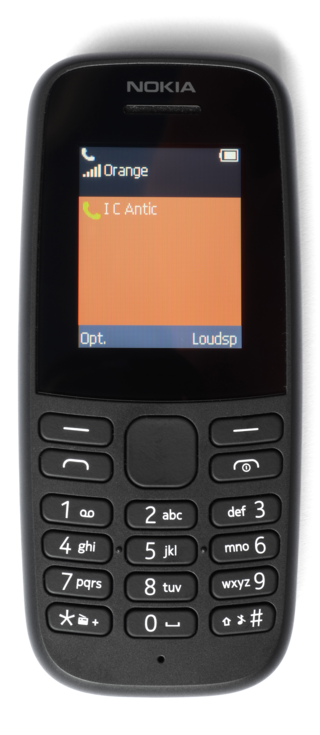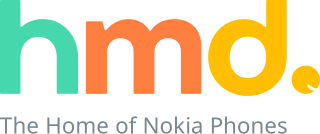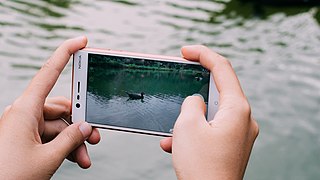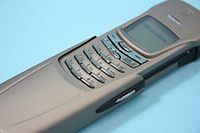
Nokia Corporation is a Finnish multinational telecommunications, information technology, and consumer electronics corporation, established in 1865. Nokia's main headquarters are in Espoo, Finland, in the greater Helsinki metropolitan area, but the company's actual roots are in the Tampere region of Pirkanmaa. In 2020, Nokia employed approximately 92,000 people across over 100 countries, did business in more than 130 countries, and reported annual revenues of around €23 billion. Nokia is a public limited company listed on the Helsinki Stock Exchange and New York Stock Exchange. It is the world's 415th-largest company measured by 2016 revenues according to the Fortune Global 500, having peaked at 85th place in 2009. It is a component of the Euro Stoxx 50 stock market index.

The S60 Platform was a software platform for smartphones that runs on top of the Symbian operating system. It was created by Nokia based on the 'Pearl' user interface from Symbian Ltd. It was introduced at COMDEX in November 2001 and first shipped with the Nokia 7650 smartphone. The platform has since seen 5 updated editions. Series 60 was renamed to S60 in November 2005.
The Nokia 8850 is a mobile phone handset manufactured by Nokia. It was a light alloy-bodied enhanced version of Nokia 8210 model with slider protection of the keypad and white lighting of the keypad and screen. The 8850 is considered to be an un-repairable phone, thus resulting in very few active handsets in the market. Today it remains a collector's item. It also came in gold. It was introduced as a successor of an earlier model, the chrome phone Nokia 8810.

The Samsung SPH-N270 or Matrix phone is a bar style mobile phone released in 2003, made to resemble the phone used in The Matrix Reloaded. The design crew of the Matrix worked closely with Samsung to develop a phone whose features and release date would coincide with the movie. The SPH-N270 was not intended as a mainstream phone for everyday use. Instead, it was marketed solely to fans of the series as a piece of rare, high quality merchandise.

The Nokia N97 is a high-end smartphone introduced on 2 December 2008 by telecommunications manufacturer Nokia as part of its Nseries and released in June 2009 as the successor to the Nokia N96 phone. The N97 was Nokia's second S60-based touchscreen phone, after the Nokia 5800 XpressMusic. The device featured slide-out QWERTY keyboard, and ran on the Symbian v9.4 operating system. Its design took cues from the Nokia N79. A smaller 'mini' version was later released.

The Sony Ericsson Satio (U1) is a smartphone, announced by Sony Ericsson at the Mobile World Congress in Barcelona, Spain on 15 February 2009 as the Idou. It was released on 7 October 2009 in the UK in 3 colour schemes: Black, Silver and Bordeaux (Red).

Samsung GT-i8910 Omnia HD is a smartphone manufactured by Samsung Electronics, first announced at MWC 2009 on February 18, 2009. The device was the first phone capable of playing and recording 720p HD video. It runs on the S60 5th Edition (Symbian^1) platform, the only Samsung device to do so.
Nokia's strategic nomenclature can be traced back in 2005 when the Nseries line was launched, offering devices with flagship specifications and premium hardware at various price points. These devices were considered the "bread and butter" of the company and were often positioned to showcase their latest technologies. Thanks to the newfound consumer and enterprise interest in smartphones at the time, the company introduced four additional collections to diversify their product portfolio and meet demands in most market segments. These new phone series were named Eseries, targeting small business and enterprise customers; Xseries, providing consumer-grade multimedia-focused devices; Cseries, which Nokia used to target both the low-end and mid-range market segments; and Tseries, for devices exclusive to the Chinese market.

Microsoft Lumia is a discontinued line of mobile devices that was originally designed and marketed by Nokia and later by Microsoft Mobile. Introduced in November 2011, the line was the result of a long-term partnership between Nokia and Microsoft—as such, Lumia smartphones run on Microsoft software, the Windows Phone operating system; and later the newer Windows 10 Mobile. The Lumia name is derived from the partitive plural form of the Finnish word lumi, meaning "snow".

The Nokia X family was a range of budget smartphones that was produced and marketed by Microsoft Mobile, originally introduced in February 2014 by Nokia. The smartphones run on the Nokia X platform, a Linux-based operating system which was a fork of Android. Nokia X is also known generally as the Nokia Normandy. It is regarded as Nokia's first Android device during the company's Microsoft partnership and was in the process of selling its mobile phone business to Microsoft, which eventually happened two months later.

Series 30+ is a software platform and application user interface used for Nokia-branded mobile devices. The platform was introduced by Nokia in September 2013, first appearing on the Nokia 108, and has been the main Nokia feature phone operating system after the end of the Series 30 and Series 40 platforms in 2014. Despite the similar name and user interface, S30+ is technically completely different and unrelated to S30.
The Nokia 8910i is a luxury mobile phone by Nokia announced on 4 November 2002 and released in early 2003. It had a metal titanium casing and a chromium-plated keypad. It was a minor improvement over the Nokia 8910, with a new colour screen and MMS capability. Both were succeeded by Nokia 8800.

HMD Global Oy, branded as HMD and Nokia Mobile, is a Finnish mobile phone manufacturer. The company is made up of the mobile phone business that Nokia sold to Microsoft in 2014, then bought back in 2016. HMD began marketing Nokia-branded smartphones and feature phones on 1 December 2016. The company has exclusive rights to the Nokia brand for mobile phones through a licensing agreement. The HMD brand is only used for corporate purposes and does not appear in advertising, whereas the name "Nokia Mobile" is used on social media.

The Nokia 6 is a Nokia-branded mid-range smartphone running on Android. It is the first smartphone from the Finnish company HMD Global, created through the partial divestment of Nokia's devices division; the first Nokia-branded smartphone since the Lumia 638; and the first Nokia-branded Android smartphone since the short-lived Nokia X2 in 2014. The phone was first announced for sale in China on January 8, 2017, with a global version announced the following month.

The Nokia 3 is a Nokia-branded entry-level Android smartphone designed and marketed by HMD Global. It was announced on 26 February 2017, a day before the Mobile World Congress started, along with the Nokia 6, Nokia 5, and Nokia 3310 (2017). The phone receives regular monthly security updates and runs stock Android. Nokia 3.1 and others released after Nokia 3.
The Nokia 7 is a mid-range Nokia-branded smartphone running Android, by HMD Global. It was launched on 19 October 2017 and was released on 24 October exclusively in China.

The Nokia 7 Plus is a Nokia-branded upper-mid-range smartphone running the Android operating system. It was announced on 25 February 2018, along with four other Nokia-branded phones.
The Nokia 3.1 is a Nokia-branded entry-level Android smartphone released in May 2018 by HMD Global. It is the successor to Nokia 3. It was launched with Android 8.0 "Oreo", which could be updated to Android 10. The phone is part of Google's Android One program.
The Nokia 3.2 is a Nokia-branded entry-level smartphone released 21 May 2019 running the Android operating system.














